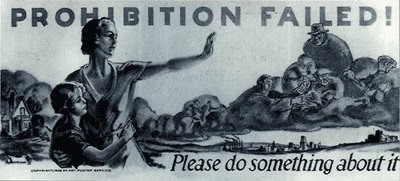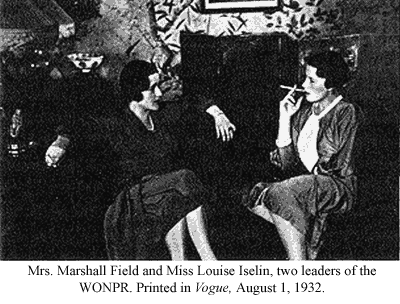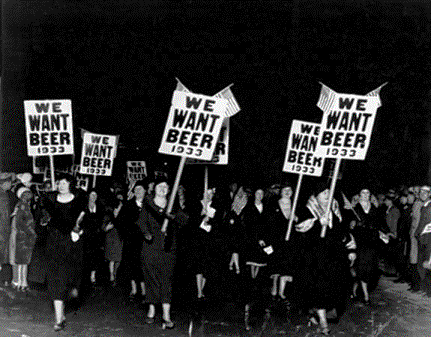HERstory
WONPR 1.0
1619
1766
1850

1860
1906
1911
1914
PROHIBITION ERA BEGINS

1919
1919
1923

1925

1928

May 1929

May 1929
Pauline Morton Sabin founded the Women’s Organization for National Prohibition Reform (WONPR). She was known for her social status and charismatic personality. Sabin’s efforts were a significant factor in the repeal of Prohibition. The Women of WONPR were considered smart and sophisticated women of the era.Their high social status attracted press coverage and made the movement fashionable. For housewives throughout middle America, joining WONPR was an opportunity to mingle with high society. In less than two years, membership grew to almost 1.5 million, this was triple the membership of the Women’s Christian Temperance Union. Sabin became a symbol for independent women; she showed women that they weren’t bound to support the Prohibition movement. Her picture appeared on the cover of Time magazine.
Pauline Morton Sabin – Ken Burns Prohibition Series
Full Ken Burns Prohibition Series
Pauline Morton Sabin talking on October 9, 1929 in New York
1930

1932

1932


December 5, 1933
POST PROHIBITION ERA BEGINS
1937
1942
1942
1944
1961
1970
June 18, 1971
1971
1972
1972
1973

1980’s
1983
1986
1988
1998
2001
2003
WONPR 2.0

1985
1993

July 1994

November 1995
1995

October 6, 1995
LEGALIZATION ERA BEGINS
November 5, 1996

March 12, 1997
July 1997

November 4, 1997

March 12, 1998
November 3, 1998
1998

2000
May 14, 2001
April 20, 2003
November 5, 2003
High school students are held at gunpoint by police during a drug raid at Stratford High School in Goose Creek, South Carolina after they had been tipped off by the school’s principal about possible marijuana sales at the school. The kids were forced into the halls and told to get down on the floor where they were held at gunpoint until the school was searched. No marijuana, narcotics or guns were found on the premises.
Surveillance Video of Goose Creek Raid
News Coverage of Goose Creek Raid
CNN Archives – 11/10/2003 – Goose Creek Raid
ACLU involvement in Goose Creek Raid
Drug War Chronicles (DRC.Net) Article on Goose Creek Raid that prompted Jean & Cher to relaunch WONPR
WINTER 2003 – CHER FORD MCCULLOUGH AND JEAN MARLOWE, ALONG WITH KAY LEE, JOINSWITH REV. JESSE JACKSON AND RAINBOW PUSH COALITION IN CHARLESTON, SC TO RALLY AGAINST GOOSE CREEK RAIDS. WONPR 2.0 IS BORN!
FEATURED CONTENT – EXCELLENT ARCHIVAL RESOURCE! FOR WONPR 2.0.
Drug War Chronicles (DRC.Net) interview with WONPR 2.0 Co-founders Cher Ford McCullough (President) and Jean Marlowe (Executive Director)
December 2003

January 2004
June 6, 2005
August 13, 2005
Journey for Justice – Washington D.C.
Cher Ford McCullough Participates on Behalf of WONPR
More on J4J
2007
October 2009
January 2010
2010
Jean Marlowe Recognized in top 100 women of weed feature

2010

Spring 2010

2010
November 2010
POST LEGALIZATION ERA BEGINS
WONPR 3.0
March 14, 2011

March 17, 2011

Jodie and Kari after Cannabis Work Session
2011
Washington State Senate Bill 5073 sponsored by Senator Jeanne Kohl-Welles, to amend and clarify the law on the medical use of cannabis (marijuana) so that qualifying patients and designated providers who comply with the law will not be subject to arrest or prosecution, other criminal sanctions, or civil consequences based solely on their medical use of cannabis, and provides that patients will have access to an adequate, safe, consistent, and secure source of medical quality marijuana. The bill defines, and clarifies the provisions related to prescribing, selling, and using medical marijuana.. This bill passed the legislature in April of 2011 and on Apr 29 was partially vetoed by Governor Gregoire after she read a letter from US Attorneys Jenny Durkan and Michael Ormsby deleting the sections in Part VI, Part VII, and Part VIII of the bill that would direct employees of the state departments of Health and Agriculture to authorize and license commercial businesses that produce, process or dispense cannabis. These sections would open public employees to federal prosecution, and the United States Attorneys have made it clear that state law would not provide these individuals safe harbor from federal prosecution. No state employee should be required to violate federal criminal law in order to fulfill duties under state law.
Bill summary
Durkan influence on Gregoire Veto – and City Hall Opposition to Gutting of 5073
Fall 2011 – “No on I-502” campaign

December 2011 – “No on I502” counter protest
Press conference for I-502 signature drop offs at Election HQ
Video of Kari dressed as Grim Reaper and her boss, Mary Lou Dickerson, on opposite sides in
YOUTUBE Preview of Evergreen Documentary with Footage of Counter Protest

August 30, 2012
Sept. 6 2012
Rally Outside Federal Courthouse Where Richard Flor Was Sentenced
Kari tracks down Richard’s daughter and granddaughter who live not far from Kari in a Seattle auburn and drives all three from Washington to Montana for this rally. This is where Kari meets Chris Williams for the first time.
THE FREE CHRIS WILLIAMS CAMPAIGN IS BORN
September 8. 2012
September 24, 2012
Sept 27, 2012
November 6, 2012
Colorado and Washington State become the first states in the nation to pass laws to legalize the consumption, possession, and sale of marijuana for recreational use. Initiative 502 in Washington was initially submitted as a bill in the State Legislature, but when it did not move forward during the 2011 session, I-502 was placed on the statewide ballot. The initiative summary reads: “This measure would license and regulate marijuana production, distribution, and possession for persons over twenty-one; remove state-law criminal and civil penalties for activities that it authorizes; tax marijuana sales; and earmark marijuana-related revenues.”
White house petition for Chris; fax blast campaign to judge; international media blitz Post-trial settlement offers; settlement conference with Malloy; Post-conviction agreement; 5 years instead of 85 year mandatory
DAY AFTER THE ELECTION!
Media Blitz Coverage on Chris Williams Case Between Trial (Sept ‘12) and Sentencing (Feb ‘13)
Nearly 30,000 Signatures collected on White House petition, triggering response from President Obama
Spinoff petitions at MoveOn.Org, Change.Org and Care2.org also ciruclate, bringing in a total of 40,000+ signatures between all platforms
Most of Williams’ Convictions to Be Dropped, Post Trial, After Unanimous Guilty Verdict by Jury – This Has NEVER Before Happened In History That We Know Of
Relevant Legal scholar articles on novelty of Williams post conviction deals and negotiations by nationally renowned sentencing expert and law professor Douglas Berman
February 1, 2013
Chris Williams is Sentenced
Kari arranged the J4J to ensure a packed courtroom at Williams sentencing hearing. Knowing Montanans were too scared to turn out in support, from prior experience with rallies related to this case, Kari decided to bus in activists from CA, OR, WA who cared about the case enough to travel to Montana.
Coverage of the J4J and Williams sentencing hearing:
https://missoulian.com/news/local/montana-medical-marijuana-grower-gets-5-years-in-federal-prison/article_89211f90-6ca5-11e2-aa17-001a4bcf887a.html
https://www.huffpost.com/entry/chris-williams-marijuana-sentenced_n_2600699
https://missoulian.com/news/local/montana-medical-marijuana-grower-gets-5-years-in-federal-prison/article_89211f90-6ca5-11e2-aa17-001a4bcf887a.html
https://archive.thinkprogress.org/montana-medical-marijuana-grower-shaves-sentence-down-from-85-years-but-hell-still-spend-5-in-jail-be2984a451df/
KETTLE FALLS FIVE ERA
Summer 2012
August 2012
February 2013
February 2013
February 2013
Spring 2013

Spring 2013 to Spring 2015

Spring 2013
August 2013
August 29, 2013
Cole Memo 2.0 outlines regulatory expectations for cannabis.
Following the passage in 2012 of initiatives in Washington and Colorado, Deputy U.S. Attorney General James Cole provided a memo for all U.S. attorneys.The memo is titled Guidance Regarding Marijuana Enforcement (PDF).The guidance “rests on the expectation that states and local governments that have enacted laws authorizing marijuana-related conduct will implement strong and effective regulatory and enforcement systems.”
May 2013
Lynn Johnson Testimonial
Northwest Leaf feature about WOW

Hempfest 2013

May 7, 2014

May 30, 2014 – Rohrabaher Farr passes the House
Summer 2014
Kari and Larry return to Washington D.C. for U.S. Senate Visits
The Rohrabacher Farr amendment is introduced in the Senate by Sens. Rand Paul and Cory Booker on June 18, but was not allowed a vote
Hempfest 2014 – Rohrabacher – Farr and Congress
December 2014
December 16, 2014
December 2014
January 16, 2015
February 2015
March 2015
March 2015
April 8, 2015
Congressmembers send letter to DOJ asking US Attorneys to uphold Rohrabacher-Farr Amendment to halt prosecutions in states where medical marijuana laws are being followed.
https://rollcall.com/2015/04/09/farr-rohrabacher-tell-holder-cool-it-on-pot-prosecutions/
https://www.safeaccessnow.org/reps_rohrabacher_farr_doj_letter
August 2015
Hempfest 2015 – HBHH Merger of Medical


